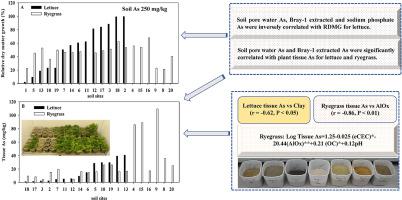当前位置:
X-MOL 学术
›
Environ. Pollut.
›
论文详情
Our official English website, www.x-mol.net, welcomes your feedback! (Note: you will need to create a separate account there.)
Predicting the modifying effect of soils on arsenic phytotoxicity and phytoaccumulation using soil properties or soil extraction methods.
Environmental Pollution ( IF 8.9 ) Pub Date : 2020-04-02 , DOI: 10.1016/j.envpol.2020.114501 Xiaoqing Zhang 1 , Elizabeth A Dayton 2 , Nicholas T Basta 2
Environmental Pollution ( IF 8.9 ) Pub Date : 2020-04-02 , DOI: 10.1016/j.envpol.2020.114501 Xiaoqing Zhang 1 , Elizabeth A Dayton 2 , Nicholas T Basta 2
Affiliation

|
Soils have the ability to modify contaminant bioavailability and toxicity. Prediction the modifying effect of soil on arsenic phytoaccumulation and phytoavailability using either soil property data or soil chemical extraction data in risk assessment of contaminated soil is highly desirable. In this study, plant bioassays important to ecological receptors, were conducted with 20 soils with a wide range in chemical and physical soil properties to determine the relationships between As measured by soil chemical extraction (soil pore water, Bray-1, sodium phosphate solution, hydroxylamine hydrochloride, and acid ammonium oxalate) or soil physico/chemical properties on arsenic phytotoxicity and phytoaccumulation. Soil pore water As and Bray-1 extracted As were significantly (P < 0.01) correlated with lettuce tissue As and those extractants and sodium phosphate were correlated with ryegrass tissue As. Hydroxylamine and acid ammonium oxalate extractions did not correlate with plant bioassay endpoints. Simple regression results showed that lettuce tissue relative dry matter growth (RDMG) was inversely related to tissue As concentration (r2 = 0.85, P < 0.01), with no significant relationship for ryegrass. Soil clay exhibited strong adsorption for As and significantly reduce tissue As for lettuce and ryegrass. In addition to clay content, reactive aluminum oxide (AlOx), reactive Fe oxide (FeOx) and eCEC was inversely related to ryegrass tissue As. Multiple regression equation was strongly predictive (r2 = 0.83) for ryegrass tissue As (log transformed) using soil AlOx, organic matter, pH, and eCEC as variables. Soil properties can greatly reduce contaminant phytoavailability, plant exposure and risk, which should be considered when assessing contaminant exposure and site-specific risk in As-contaminated soils.
中文翻译:

使用土壤性质或土壤提取方法预测土壤对砷的植物毒性和植物累积的改良作用。
土壤具有改变污染物生物利用度和毒性的能力。在污染土壤的风险评估中,使用土壤特性数据或土壤化学提取数据来预测土壤对砷植物累积和植物利用率的改良效果是非常必要的。在这项研究中,对20种土壤具有广泛的化学和物理性质的土壤进行了对生态受体重要的植物生物测定,以确定之间的关系。通过土壤化学提取(土壤孔隙水,Bray-1,磷酸钠溶液,盐酸羟胺和草酸酸铵)或土壤对砷的植物毒性和植物累积的理化特性。土壤孔隙水As和Bray-1提取的As含量显着(P <0。01)与生菜组织As相关,而那些萃取剂和磷酸钠与黑麦草组织As相关。羟胺和酸草酸铵的提取与植物生物测定的终点不相关。简单的回归结果表明,生菜组织相对干物质生长(RDMG)与组织As浓度成反比关系(r2 = 0.85,P <0.01),与黑麦草无显着关系。土壤黏土显示出对As的强吸附能力,并显着减少生菜和黑麦草的组织As。除粘土含量外,反应性氧化铝(AlOx),反应性Fe氧化物(FeOx)和eCEC与黑麦草组织As成反比。使用土壤AlOx,有机质,pH和eCEC作为变量,多变量回归方程对于黑麦草组织As(对数转换)具有很强的预测性(r2 = 0.83)。
更新日期:2020-04-20
中文翻译:

使用土壤性质或土壤提取方法预测土壤对砷的植物毒性和植物累积的改良作用。
土壤具有改变污染物生物利用度和毒性的能力。在污染土壤的风险评估中,使用土壤特性数据或土壤化学提取数据来预测土壤对砷植物累积和植物利用率的改良效果是非常必要的。在这项研究中,对20种土壤具有广泛的化学和物理性质的土壤进行了对生态受体重要的植物生物测定,以确定之间的关系。通过土壤化学提取(土壤孔隙水,Bray-1,磷酸钠溶液,盐酸羟胺和草酸酸铵)或土壤对砷的植物毒性和植物累积的理化特性。土壤孔隙水As和Bray-1提取的As含量显着(P <0。01)与生菜组织As相关,而那些萃取剂和磷酸钠与黑麦草组织As相关。羟胺和酸草酸铵的提取与植物生物测定的终点不相关。简单的回归结果表明,生菜组织相对干物质生长(RDMG)与组织As浓度成反比关系(r2 = 0.85,P <0.01),与黑麦草无显着关系。土壤黏土显示出对As的强吸附能力,并显着减少生菜和黑麦草的组织As。除粘土含量外,反应性氧化铝(AlOx),反应性Fe氧化物(FeOx)和eCEC与黑麦草组织As成反比。使用土壤AlOx,有机质,pH和eCEC作为变量,多变量回归方程对于黑麦草组织As(对数转换)具有很强的预测性(r2 = 0.83)。



























 京公网安备 11010802027423号
京公网安备 11010802027423号